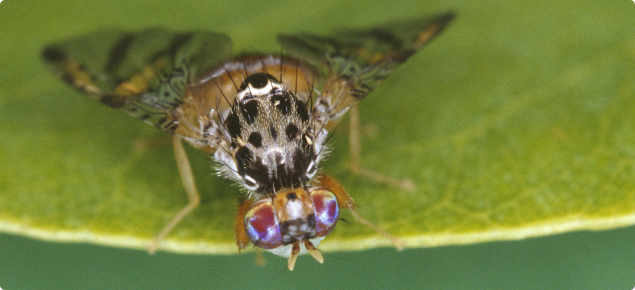Damage
The first sign of damage is often larvae-infested or ‘stung’ fruit. Stinging is caused by the female laying eggs into unripened or ripe fruit. Larvae may develop from the eggs, depending on when they are laid and the fruit type.
For example, stings can occur in apples and peaches when they are unripe, but the eggs do not hatch at this stage. As the fruit ripens the eggs can develop.
Life cycle
Medfly activity depends on temperature. In the South West medfly is active in late spring, summer and autumn. In winter, it can become inactive in cold areas. Medfly can overwinter as adults, eggs and larvae (in fruit), or as pupae in the ground. Adult medflies are active in winter when temperatures exceed 12°C.
As temperatures increase in spring, adults begin to emerge from the ground and overwintering flies become active. If control is not started at this time, medfly populations will increase to cause problems later in the season.
Adult stage
The adult fly is 3–5mm long. Its body is light brown and the abdomen is encircled by two light-coloured rings. The thorax (middle) has irregular patches of black and silver, giving it a mosaic appearance. The wings are mottled with distinct brown bands extending to the wing tips.
Don't confuse Medfly for Queensland fruit fly (Qfly), which is larger and reddish brown and has clear wings. Refer to the Qfly web pages for more identifying information.
The Medfly female has an ovipositor or egg-laying organ but the male does not. Adult Medflies may live for two to three months and are often found in fruit tree foliage, especially citrus trees. As long as fruit is present most Medflies do not move more than 50 metres. However, they will travel further if no hosts are present.
Eggs
Medflies prefer to lay eggs in soft-fleshed fruit such as apricots, peaches, plums and nectarines. When Medfly numbers are high and competition is greater, females become less choosy and will infest less preferred hosts such as olives.
They will also infest such fruits or vegetables if preferred hosts are not available, even when their populations are low.
Once a suitable host is found, the ovipositor is used to pierce the fruit skin. Batches of up to 300 white banana-shaped eggs are laid into this hole. Eggs are just visible to the naked eye and take 2–4 days to hatch in summer and 19–20 days in winter.
The eggs and larvae of Qfly and Medfly are almost identical, and larval identification needs to be carried out by an expert.
Larvae (maggots)
The larvae are white with a flat, pointed head. This stage of the life cycle is when they are most likely to be seen. When the larvae first hatch they are about 1mm long, but grow quickly to 8mm. The larvae feed on the fruit, causing it to decompose.
When fully grown, larvae stop feeding and jump out from the fruit, burrowing into the soil to pupate. The larval stage takes about 14–16 days in summer and 25–45 days in winter.
Pupae
Pupae resemble small brown capsules or barrels about 4mm long. Within the pupal case the medfly slowly develops into an adult. When mature the adult fly cuts through the case and burrows up through the soil. The pupal stage lasts 12–14 days in summer and 25–50 days in winter.



